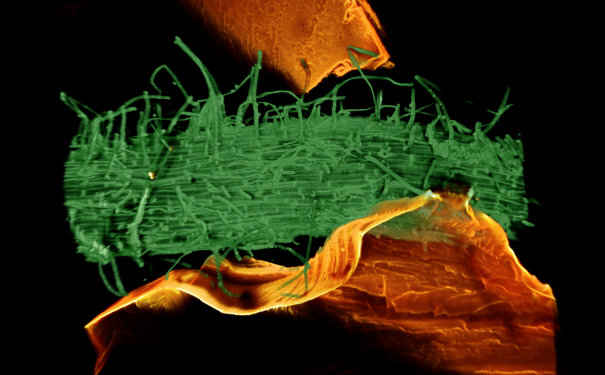
Nafion has a low refractive index and high transparency, making it ideal to observe the plant roots through. Image: Lionel Dupuy
The mysterious world of the rhizosphere revealed.
Understanding soil processes is essential for addressing global issues of food security, disease transmission and climate change. However, techniques for observing soil biology are lacking. Artificial soil-like materials have been developed to help scientists image the secret world of plant roots. This could help biologists, chemists and physicists improve crops and identify ways to prevent the outbreak of plant-based diseases.
The transparent soil was developed by theoretical biologist Lionel Dupuy at the James Hutton Institute in Dundee, Scotland. It gives scientists a much better and more realistic window into how a plant’s rhizosphere — the roots and the organisms living within them — works. It is composed of a material called Nafion, which has a low refractive index and high transparency. Nafion is normally used in power-generating fuel cells that also has the ability to support bacteria and can be modified to mimic the chemicals of natural soils.
“My initial aim was to develop microscopy techniques to observe and study how roots get round obstacles or find optimal trajectories towards water and nutrients,” Dupuy says. “I was looking for a way to create 3D obstacles for the root and still be able to observe them. However, as we progressed in our work, it became clear that we could make a new substrate that resembles a real soil, and that this could have many applications.”
The soil has already been used to examine the interaction between E.coli bacteria and lettuce roots, providing insight into ways to avoid contamination before the produce reaches the shelves. The researchers used a genetically modified version of E. coli that carried a green fluorescent protein from jellyfish and watched how it behaved with the vegetable. They saw the bacterium form micro-colonies in the root zone that likely helps them survive outside of guts. It can also be used to study root system efficiency and provide improvement solutions.
“If we understand better the contamination route, then we can develop strategies to limit the transfer of E. coli to the food chain,” Dupuy says. “We don’t really understand how E. coli enters the food chain, particularly for fresh produce.”
 Other than the study of the spread and transmission of soil borne pathogens, Dupuy asserts that there are many different disciplines that could benefit from this research. For instance, in crop genetics it could be used to screen the root systems of a range of genotypes, which would help breed crops with more efficient root systems so that agriculture can rely less on fertilisers. Physiologists could also use transparent soils to understand how plants or microbes access nutrients that are heterogeneously distributed in soil, and soil ecologists could use this system to make microcosm experiments where observation on interactions of different species can be observed.
Other than the study of the spread and transmission of soil borne pathogens, Dupuy asserts that there are many different disciplines that could benefit from this research. For instance, in crop genetics it could be used to screen the root systems of a range of genotypes, which would help breed crops with more efficient root systems so that agriculture can rely less on fertilisers. Physiologists could also use transparent soils to understand how plants or microbes access nutrients that are heterogeneously distributed in soil, and soil ecologists could use this system to make microcosm experiments where observation on interactions of different species can be observed.
“If we want to make crops and agriculture more efficient, we need to gather information at the molecular level so that we can breed more efficiently for advantageous root traits,” Dupuy explains.
Nafion-based soil is extremely expensive (five dollars per gram), but researchers are looking into finding a more affordable material. Dupuy notes that there are already other alternatives based on products from the Teflon family. In particular, Teflon FEP is more widely available and solutions using this material could be made cheaper.
“Future work will focus on controlling a greater range of chemical and physical properties so that applications of transparent soils to the many disciplines of soil biology are possible,” Dupuy says. “I think there is also a real challenge to make this technique low cost so that it can be used by everyone and at a larger scale e.g. in glasshouse studies.”






